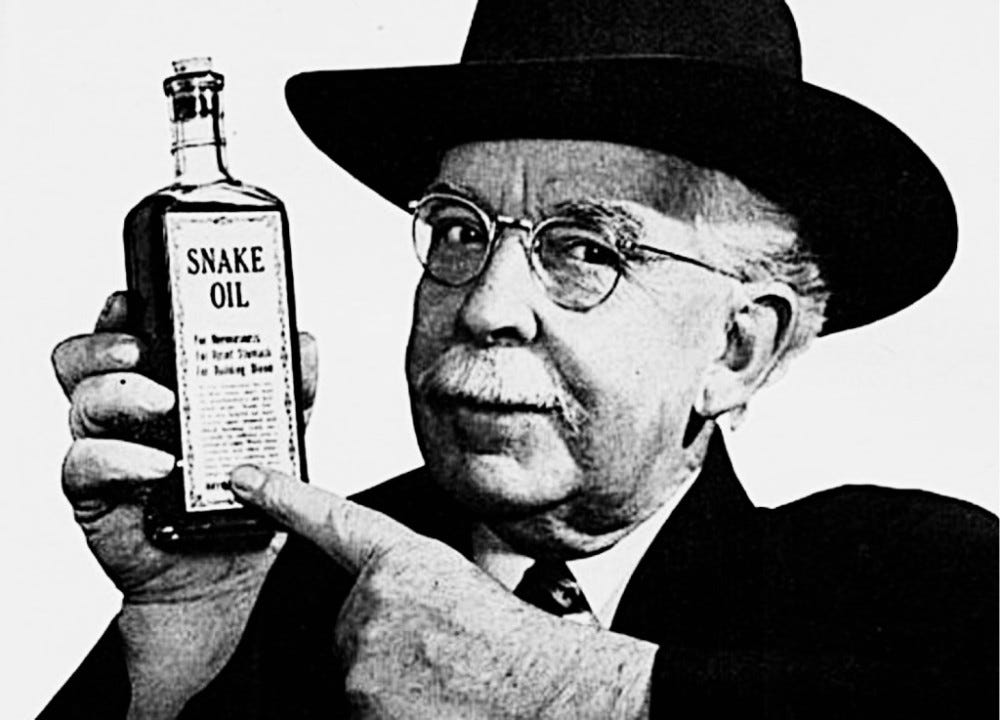You Think You Need to Invest in Paid Ads. You Probably Shouldn’t.
5 scenarios where paid ads don't make sense
Almost without fail, when prospects approach me for help, the first thing out of their mouths is, “We need help running our paid online advertising.” Whether it is Google Ads, Instagram Ads, TikTok Ads or something else, the average business owner or entrepreneur is fixated on the notion that paying for online ads is the only way to grow their business. When I drill down deeper and begin to better understand their businesses, I will invariably ask, “Why are you so set on paid ads? Have you considered X, Y, Z?” Upon hearing this question, most folks will have a bewildered look on their faces, like they have just been snapped out of a trance. “Oh…we had never considered that…we had just heard that paid ads was a good strategy...”
In the heyday of paid advertising (a period I would roughly classify as 2010 to 2019) you could be virtually clueless and still see solid results. Especially earlier in this period, competition was low, cost-per-clicks were rock bottom, and knowledge on best practices was not widely known. 2024 is an entirely different story. Paid advertising is now a mature industry with a tremendous amount of competition. Tracking has gotten a lot trickier, cost-per-clicks have risen, and things are changing at a rapid pace. In 2010, if someone was reasonably smart and good at number crunching, running paid ads was like being an athletic 6’3” guy and dominating a YMCA basketball league where all the competition is 5’6”. In 2024, it is like trying to compete in the NBA.
In fairness, I am not suggesting that paid ads no longer work or that it is impossible to see a good return. There is still a tremendous amount of opportunity in the space and the best advertisers are still going to make a lot of money. However, in 2024, paid ads is very much a game of inches where having a deep knowledge of best practices and how best to optimize campaigns is essential in order to make a solid profit. Paid ads are not going to be a good fit for everyone and if you are not an experienced and advertiser, I would highly suggest working with someone who is. In this article, I am going to share a step-by-step checklist you can walkthrough in order to determine whether you should consider paid ads or whether it makes more sense to invest in other strategies.
#1 - Are you in a sensitive industry?
Adult content. Gambling. Pharmaceuticals. These are just some of the many industries that are either banned or restricted across one or more of the major online ad platforms. Google Ads, Meta Ads, and LinkedIn Ads all have slightly different categories they restrict, but each has a firm line they will not allow you to cross. What should you do if your company falls within one of these industries? Assuming you still want to take a crack at running paid ads, I would suggest taking a few steps:
1). Set up and run a basic ad campaign and see what happens - While the rules themselves are fairly explicit, how they are applied is a different story. Ads set up by one advertiser might get immediately flagged, while similar ads set up by another might never have an issue or might be able to run for 6+ months before anything happens. The only way to find out is to launch something basic, wait at least a few days, see the response, then re-evaluate from there.
2). See if there are any certifications you can apply for or applications you can submit - In some cases, you can submit an application to Google explaining why your ads falls within their acceptable guidelines or you can get approved for a certification like LegitScript which enables you to run. While this sounds good on paper, by and large, I have found both to be extremely ineffective. Applications you submit to Google to explain your case are almost always directed to offshore reps, typically in countries like India or The Philippines, who are given strict rules and checklists that do not permit them any leeway. Certifications like LegitScript usually take 6+ months to acquire, and many similar certifications require you to apply on a state-by-state basis for each state you want to run ads in, making the process excessively slow.
3). Try to evade the rules via multiple accounts and copy changes - As stated above, the way the rules are applied is often very arbitrary. I have worked with some advertisers in sensitive industries who got flagged and shutdown in one ad account, spun up a second ad account which also got closed, and then finally had success with a third account that mysteriously never had an issue. I have had others where they learn that Google will flag certain words or phrases in their ad copy or website copy, but by making slight tweaks to their language, they are able to evade detection. While this step of creating multiple accounts will probably be required if you insist on advertising in a sensitive industry, speaking from experience, it is very time consuming and exhausting. It is a slog to recreate entire accounts from scratch, and even worse is the uncertainty that comes with knowing you could get shutdown again at any time for reasons that are not entirely clear.
#2 - Is your product or service sufficiently high-price or high-margin?
At the end of day, outside of all the bells and whistles, paid ads boil down to math. There are certain hard limits that exist as far as the types of results you can expect to see (some of which I discuss here), and if those limits do not provide enough wiggle room for you to make a profit, paid ads won’t make sense. I am going to provide a simple formula to help you think through this decision:
Cost-Per-Click * (100 / Conversion Rate)
* % Profit Margin
* (Total # of Customer Purchases + Total # of Word of Mouth Purchases)
=
Maximum you can pay per per customer
To provide an example that should make this a bit more concrete, let’s say that your company sells dress shoes that cost $200. You run ads on Google Ads and find that each click costs you $3 and of those clicks, 5% of visitors purchase your shoes. That results in a cost per purchase of $60 ($3 * (100 / 5)). However, you cannot count that whole $200 as profit: you have cost of materials, cost of labor, etc. which can be fairly steep. Let’s say that of the $200, you have profit margins of 25%, so $50 can actually be counted as profit. Given that you spent $60 to acquire a customer, and only received $50 back in profit, it would seem that this was not worth it for you, but this is failing to factor in customer lifetime value and word of mouth. Let’s assume that you find based on your database that each customer, on average, purchases 3 pairs of shoes over their lifetime and also tells 1 friend about your friend who also purchases 3 pairs of shoes. That means a true profit of $300 ($150 + $150), which for a $60 customer acquisition cost, means a 5x ROI, a pretty great number you can scale a business on.
However, for many types of low price or low margin products, the numbers do not pan out. Let’s say that you are trying to use online ads to promote a book you published that is priced at $20 and whose margins are 30%, so for each book sold, you get $6 in profit. Here are some hard limits you should expect when running paid ads:
Minimum cost-per-click: $2.00
Maximum conversion rate (for direct purchases): 10%
There are certainly some exceptions to these numbers. If you are running banner ads on mobile apps, you may see cost-per-clicks of $.25 or less, but these are going to be almost all mis-clicks and exceptionally low quality with virtually zero conversions. For certain industries, getting clicks in the $1-$2 range is possible, but I would not count on it. For conversion rate, these assume direct purchases - if instead you are trying to get someone to fill out a form or download something, the conversion rate can be much higher (as described here).
Keeping these numbers in mind, even in the best case scenario for your book, a $2 cost-per-click and 10% conversion rate results in a cost per purchase of $20 and $6 in profit. This means that even if every reader convinced 2 other friends to purchase (which is very rare), you would still only be getting $18 in profit while paying $20 to drive that purchase; not even breaking even. By and large, I have found that paid ads work best for single purchase items with medium to high prices (e.g. $50 minimum) or businesses with recurring revenue models.
#3 - Do you have sufficient budget?
Almost every business owner or entrepreneur I have talked to severely underestimates the cost of paid ads and how much budget is required. As stated in the introduction, paid ads have gotten substantially more competitive over the years, and I would highly suggest you hire a competent advertiser to manage things on your behalf. To be conservative, I would budget $2k/month for this. Two points to mention here:
1). With strong negotiation and searching, you might be able to find a competent advertiser to manage things for you for under $2k/month, but I would suggest being very cautious about penny pinching here. Effectively managing paid ad campaigns requires a decent amount of time, energy, and focus, and I have personally found that juggling over 5 clients at a time usually results in issues with time management and lowered performance. If someone offers to manage your ad campaigns for $500/month, they are very likely setting and forgetting it or doing a barebones setup unlikely to drive results.
2). You can take a crack at running things on your own, but I would advise against this unless you have a solid paid ads background. You don’t know what you don’t know, and it is very easy to mess up your ad tracking and be making decisions off bad data, waste hundreds or thousands of dollars on poor ad targeting, or leave tons of money on the table due to bad landing page design, incorrect bid strategies, or something else.
As a rule of thumb, $3k/month is a decent starting budget for ads, and if you are paying someone $2k/month to help you manage things, that means you need to budget $15k for a 3-month ad test. If that number seems insane to you, I would suggest pursuing other growth channels instead.
#4 - Are you able to handle uncertainty and make calculated bets?
A refrain I hear frequently from SMB clients is, “We want to be careful with our dollars, but we are willing to invest money in something when we have clear proof that it works.” While this sounds great in theory, it really does not hold up in practice. Figuring out what works best for any client requires plenty of testing and experimentation, and this inevitably will lead to some dead ends and disappointing outcomes for the sake of learning. This is a crucial part of the process, and if you neglect it and only want to bet on ‘proven strategies’, you are going to be severely capped in how far you can scale your paid ads.
Another element of this is the volatility and ups and downs that regularly occur with paid ads. Let’s say that on average, your paid ads campaigns drive 20 purchases per week. Even if you made no changes to your campaigns, purely based off of statistical variance, you are going to see the numbers fluctuate weekly. Some weeks, you might get 27 purchases, other weeks it might be 13, and other weeks, it might shift wildly within that range. If you expect to see the numbers go up every single week without fail, you are setting yourself up for disappointment and failure. Long-term success requires you to zoom out, analyze results objectively over an extended period of time, and not let blips on the radar freak you out.
A final element here is whether the paid ads are make or break for your business or whether you have any buffer or safety net. If a single bad week or month will sink your business and your eyes are glued to the screen on a daily basis, you are going to have a hard time being objective about your results and making rational, data-driven decisions. More likely than not, you are going to act impulsively, make large scale changes on a whim, and sabotage your results. While having $15k ready for a 3-month test is my suggestion in point #3, I would add on that you should also have enough of a safety net for your business that if your ad campaigns underperform, you won’t experience a mental breakdown.
#5 - Are your desired customers easy to find online?
I have worked with many clients who offer great products or services, but their target market is not easy to reach online. If you are offering a product or service that is complex or esoteric, targeting can be tricky. For example, one client I worked with was a crypto company that offered a product whose primary benefit was zero knowledge proof. Not sure what zero knowledge proof is? Neither is most of the market. Finding the small pool of prospects who knew and wanted this type of solution was exceptionally hard.
Outside of cases of complex or esoteric products or services, there are two other common scenarios where it will be difficult to reach your target market online:
1). Products or services with exceptionally high price tags: One client I worked with offered a complex software product designed for large e-commerce brands. The price tag was $100k/year. The challenge was that it is tricky with conventional paid ads targeting to screen for prospects who are ready to commit to such a massive purchase. We would help them drive hundreds of leads a month, fewer than 20% of them passed the initial screening call, and far less than 1% of them actually pulled the trigger and purchased. Another challenge is that the success or failure of the campaigns will hinge heavily on the decisions of a few key prospects, and those decisions have a heavy element of luck. For example, if you have two prospects on the verge of purchasing, it could easily happen that one gets cold feet and chooses not to buy and the other makes a last minute decision to go with a competitor. This could result in tens of thousands of dollars in ad spend with zero return, versus a highly profitable ad campaign if both had gone the other way.
2). Niche markets with very specific requirements: There are some specific criteria that are relatively easy to screen for in paid ads. For example, household income, geography, age, and gender are all targeting options in most of the major ad platforms. Others are much harder. For example, let’s say you are a medical company targeting people with diabetes, but you can only service patients with specific insurance providers and those who use specific brands of insulin. This is not easy to filter for upfront, so you are likely to waste a lot of spend on misfires. Another case might be where your target market is only 25 large companies and you need to target 5 key decision-makers at those companies. While some strategies can help you to do this (e.g. Account Based Marketing), it is still tricky and you are very likely to waste a lot of time and money filtering through many irrelevant leads.
Conclusion
While paid ads still have a lot of upside, it is not a good fit for everyone. If you operate in a sensitive industry, have a low price or low margin product or service, do not have sufficient budget, are not able to handle uncertainty or make calculated bets, and are not able to easily find your target market online, it is better to pursue growth through other methods. What should those alternative methods be? I will cover that in a future article, but for now, you should hopefully have a much clearer idea of the very real limits of paid ads.












Thanks for the article—it made me rethink my reliance on paid ads and consider whether they’re the best fit for my business. I appreciate the practical advice
Superb, and something to be very mindful of/